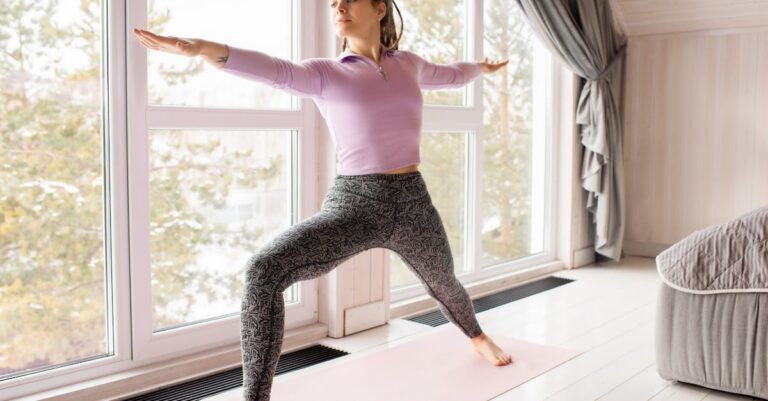So, you’re ready to tackle that workout right in your living room? High five! It’s awesome you’re making fitness happen at home. But wait a sec… are you one of those folks who jumps straight into the tough stuff? Maybe you figure a few jumping jacks count as “warmed up”? Lots of us do it, especially when we’re short on time. Here’s the thing, though: skipping a proper warm-up, especially the right kind of warm-up, can set you back. Think annoying aches, maybe even injuries, and workouts that just feel kinda ‘meh’. This article is gonna show you why a dynamic warm-up is your secret weapon for better, safer home workouts. You’ll learn what it is, why it rocks, and get simple moves you can start using today. Let’s get you prepped for success!
Why Bother Warming Up? Isn’t Moving Around Enough?
Okay, getting the blood flowing with *any* movement is better than nothing, for sure. But there’s a big difference between just kinda bouncing around and doing a dynamic warm-up. Think about it like this: imagine trying to stretch a cold rubber band really far, really fast. There’s a good chance it might snap, right? Your muscles and joints are kinda similar. When they’re “cold,” they’re less flexible and more prone to getting pulled or strained if you suddenly demand a lot from them.
A dynamic warm-up uses movement to actively warm and stretch your muscles. It’s like telling your body, “Hey, we’re about to do some work!” It gradually increases your heart rate, gets blood flowing to your muscles, and wakes up the connections between your brain and your body. This means you’re not just less likely to get hurt, but you’ll actually perform better during your workout too. You’ll feel looser, stronger, and more coordinated.
Static vs. Dynamic: What’s the Big Deal?
You’ve probably seen people doing stretches where they hold a position for like 30 seconds – like touching their toes or pulling their arm across their chest. That’s called static stretching. It has its place, maybe after a workout, but doing it before you exercise isn’t the best idea.
Why? Holding those stretches can sometimes tell your muscles to relax and chill out *too* much, which isn’t great right before you need them to be powerful and active. Dynamic stretching, on the other hand, is all about movement. Think arm circles, leg swings, walking lunges. You’re moving your joints through their range of motion. This actively warms up the muscles, improves mobility (how well your joints move), and gets your body ready for action without telling your muscles to take a nap. It’s like revving the engine before you put the car in drive, instead of just letting it idle.
Getting Your Body Ready: The Head-to-Toe Idea
A good dynamic warm-up doesn’t need to be complicated. A super simple way to think about it is starting from your head and working your way down, or vice-versa. The goal is to gently mobilize the main joints and muscle groups you’ll be using. You’re not trying to exhaust yourself, just wake everything up.
Think about the big players: neck, shoulders, torso (your core!), hips, knees, and ankles. By doing a few gentle movements for each area, you ensure that your whole body is getting the “get ready” signal. It helps you check in with how everything feels before you start asking it to do squats, push-ups, or whatever awesome stuff is in your workout plan.
Awesome Dynamic Moves You Can Do Anywhere
You don’t need any fancy equipment or tons of space for a great dynamic warm-up. Here are a few simple but super effective moves you can do right in your living room:
- Arm Circles: Stand with feet shoulder-width apart, arms out to the sides. Make small circles forward, gradually getting bigger. Do about 10-15, then reverse and do 10-15 backward circles. Great for waking up those shoulders!
- Leg Swings (Forward/Backward): Stand near a wall or chair for balance. Swing one leg gently forward and backward like a pendulum. Keep your core tight and avoid arching your back too much. Do 10-12 swings per leg.
- Leg Swings (Side-to-Side): Facing the wall/chair for balance, swing one leg out to the side and then across the front of your body. Keep it controlled. Do 10-12 swings per leg. These really open up the hips.
- Torso Twists: Stand with feet a bit wider than shoulder-width, knees slightly bent. Gently twist your upper body side to side, letting your arms swing loosely. Keep your hips relatively stable. Do 10-15 twists each way. Hello, mobile spine!
- Walking Lunges (Shallow): Take a step forward and lower your hips until both knees are bent at about a 90-degree angle (or less to start). Keep your front knee behind your toes. Push off your back foot and step through into the next lunge. Do 5-8 lunges per leg. These warm up hips, glutes, and quads.
- Cat-Cow Stretch (on hands and knees): Start on all fours. As you inhale, drop your belly towards the floor and look up slightly (Cow). As you exhale, round your spine towards the ceiling, tucking your chin (Cat). Flow between these 5-8 times. It’s fantastic for your back.
Remember: These should feel like gentle movements, not forced stretches.
Making it Stick: How Long Should This Take?
Good news! A dynamic warm-up doesn’t need to eat up half your workout time. Aim for about 5 to 10 minutes. That’s usually enough to get your heart rate up a bit, break a light sweat (maybe!), and feel looser and more prepared.
Think of it like this: if your workout is 30 minutes, dedicating 5 minutes to warming up is totally doable. How to make it a habit? Tack it onto the beginning of every single home workout. Don’t even think about starting the main event until you’ve done your warm-up moves. Some great workout plans or apps actually build this right in, so you don’t even have to think about it – the warm-up just flows into the workout. Consistency is key!
Listen to Your Body: The Golden Rule
This is super important. Your warm-up is a great chance to check in with your body. How are things feeling today? Any tight spots? Any little aches? Pay attention! Dynamic warm-ups should never hurt. If a movement feels pinchy, sharp, or just plain wrong, ease up or skip it. Maybe make the movement smaller or slower.
Let’s imagine a fictional example: maybe Alex woke up with a slightly stiff neck. During his torso twists, instead of going full range, he keeps the movement smaller and gentler, paying attention to how his neck feels. He doesn’t push through the stiffness. That’s the smart way to do it! This isn’t about pushing your limits; it’s about preparing your body safely for the work ahead.
Putting It All Together: Your Pre-Workout Mini-Routine
Okay, let’s make this easy. You can create a super simple go-to dynamic warm-up routine. Pick 4-5 moves that cover your major joints and muscles. A sample routine could look like this:
- Arm Circles (Forward & Backward, 10 each way)
- Torso Twists (10 each side)
- Cat-Cow (8 reps)
- Leg Swings (Forward/Backward, 10 each leg)
- Leg Swings (Side-to-Side, 10 each leg)
- Shallow Walking Lunges (6 each leg)
Do each move smoothly and continuously. In about 5-7 minutes, you’ll feel warmer, looser, and way more ready to tackle your main workout. Feel free to swap moves based on what feels good or what your workout focuses on!
Alright, let’s wrap this up! We talked about why just jumping into your home workout isn’t the best plan and how a dynamic warm-up is your secret sauce. Remember, it’s different from those old-school static stretches you hold forever. Dynamic means moving – think arm circles, leg swings, and torso twists – to gently warm up your muscles and joints. This helps prevent injuries (no one wants those!) and actually makes your workout feel better. Just 5-10 minutes is all it takes. Pick a few moves, maybe work from head-to-toe, listen to your body, and make it a habit before every single session. Your body will definitely thank you for it later!









